Abstract
The Joint Polar Satellite System (JPSS) mission has provided over ten years of high-quality data products for environment forecasting and monitoring through the current Suomi National Polar-orbiting Partnership (S-NPP) and NOAA-20 satellites. Particularly, the sensor data record (SDR) and the derived environmental data record (EDR) products from the Visible Infrared Imaging Radiometer Suite (VIIRS), the Cross-track Infrared Sounder (CrIS), the Advanced Technology Microwave Sounder (ATMS), and the Ozone Mapping and Profiler Suite (OMPS) offer an unprecedented opportunity to observe severe weather and environmental events over the Earth. This paper presents the observations about atmospheric features of the Hunga Tonga Volcanic eruption of January 2022, e.g., the gravity wave, volcanic cloud, and aerosol (sulfate) plume phenomena, by using the ATMS, CrIS, OMPS, and VIIRS SDR and EDR products. Powerful gravity waves ringing through the atmosphere after the eruption of the Hunga Tonga volcano are discovered at two CrIS upper sounding channels (670 cm−1 and 2320 cm−1) in the deviations of the observed brightness temperature (O) from the simulated baseline brightness temperature (B) using the Community Radiative Transfer Model (CRTM), i.e., O—B. A similar pattern is also observed in the ATMS global maps at channel 15, whose peak weighting function is around 40 km, showing the atmospheric disturbance caused by the eruption that reached 40 km above the surface. The Tonga volcanic cloud (plume) was also captured by the OMPS SO2 EDR product. The gravity wave features were also captured in the native resolution image of the S-NPP VIIRS I-5 band nighttime observations. In addition, the VIIRS Aerosol Optical Depth (AOD) captured and tracked the volcanic aerosol (sulfate) plume successfully. These discoveries demonstrate the scientific potential of the JPSS SDR and EDR products in monitoring and tracking the eruption of the Hunga Tonga volcano and its severe environmental impacts. This paper presents the atmospheric features of the Hunga Tonga volcano eruption that is uniquely captured by all four advanced sensors onboard JPSS satellites, with different spectral coverages and spatial resolutions.
1. Introduction
The Joint Polar Satellite System (JPSS) is the National Oceanic and Atmospheric Administration’s (NOAA) operational program that provides continuity of global environmental data from multiple polar-orbiting satellites. The Suomi National Polar-orbiting Partnership (S-NPP) satellite launched on 18 October 2011, was the first JPSS satellite and serves as the predecessor to the JPSS-1 satellite (renamed as NOAA-20 after being handed over to NOAA for operations), which was launched on 18 November 2017. The S-NPP satellite, orbiting in a 1:30 AM/PM polar orbit, has been extremely successful in operations for the last ten years and has produced an array of high-quality products in the areas of atmospheric, land, ocean, and cryosphere data products [1,2,3]. These products are built on the measurements of Sensor Data Record (SDR) data from five major instruments: the Visible Infrared Imaging Radiometer Suite (VIIRS), the Cross-track Infrared Sounder (CrIS), the Advanced Technology Microwave Sounder (ATMS), the Ozone Mapping and Profiler Suite (OMPS) and Clouds and the Earth’s Radiant Energy System (CERES). Details of these instruments, including their channel characteristics and the instrument calibration, and the science products derivable from these instruments, are discussed in detail in the Algorithm Theoretical Basis Document (ATBD) (https://www.star.nesdis.noaa.gov/jpss/Docs.php) (accessed on 23 January 2023) [4,5,6,7]. The JPSS-1/NOAA-20 satellite is also in a 1:30 AM/PM orbit with a 50-min separation from the S-NPP orbit. NOAA-20 features five similar instrument complements on S-NPP and provides continuity of the high-quality data products, along with additional products as a direct result of instrument upgrades and science improvements.
The JPSS constellation of polar-orbiting satellites provides a diverse set of ultraviolet (UV), visible (VIS), infrared (IR), and microwave (MW) sensors and essential science data products for many important applications in operational weather forecasting, environmental monitoring, and climate research. In particular, the SDR and the derived environmental data products (EDR) can be used to visually monitor land and atmospheric features and evolutions of severe weather events without complicated physical or dynamic models. For example, the SDR data products from the ATMS and the VIIRS are successfully utilized to visually examine the vertical structure of the hurricane warm cores in the operational hurricane monitoring systems [8].
It was recently reported that the Hunga Tonga volcano started its activity in late December 2021. A large volcanic eruption commenced in the early hours of 14 January 2022. A much larger eruption of an underwater volcano then started at 5:26 p.m. local time on 14 January (UTC 04:26, 15 January). The volcano is located at [20.55 S, 175.38 W, https://volcano.si.edu/] (accessed on 23 January 2023). A series of important studies were conducted to understand the occurrence, characterization, evolution, and impact of the volcano event (e.g., [9,10,11,12,13,14,15,16,17]). It is important to investigate the climate impact of the gasses and the ash particles injected into the atmosphere during the volcanic eruption because most of the ash particles can cool the planet by shading incoming solar radiation. In the meantime, it is also interesting to examine atmospheric features due to the eruption from satellite observations. The Hunga Tonga volcano event was successfully monitored by using satellite observations. For example, two weather satellites, NOAA’s Geostationary Operational Environmental Satellite 17 (GOES-17) and the Japanese Aerospace Exploration Agency’s (JAXA) Himawari-8, observed that the height and breadth of the plume from the volcanic eruption rose to 58 km (36 miles) (https://earthobservatory.nasa.gov/images/149474/tonga-volcano-plume-reached-the-mesosphere) (accessed on 23 January 2023). In particular, stereo methods using GOES-17 and Himawari-8 were applied to the volcanic plume to retrieve both the height and the motion of the volcanic plume nearly continuously [9]. Another study used a combination of space-borne instruments (e.g., CALIOP, OMPS-LP, IASI, MLS, ALADIN, GEOs) to study the evolution and dynamics of the stratospheric plume after the Hunga Tonga eruption [15]. Here, the CALIOP stands for Cloud-Aerosol Lidar with Orthogonal Polarisation, the OMPS-LP stands for the Ozone Mapping and Profiler Suite Limb Profiler, the IASI stands for Infrared Atmospheric Sounding Interferometer, the MLS stands for Microwave Limb Sounder, the ALADIN stands for Atmospheric Laser Doppler Instrument, and the GEOs stands for geostationary orbit data, such as Himawari-8.
In fact, the observations and derived scientific products from most of the S-NPP and NOAA-20 instruments also show an ability to visually capture atmospheric features resulting from this volcanic event. The gravity waves generated by the eruption were observed by ATMS, CrIS, and VIIRS instruments across different spectral regions and with different spatial resolutions. Both the S-NPP and NOAA-20 satellites just passed over the eruption area right before the eruption. The next pass was about 8 h after the eruption. In this paper, we present observational results about the atmospheric features due to the Hunga Tonga volcanic eruption by using both SDR and specific EDR products from JPSS ATMS, CrIS, OMPS, and VIIRS sensors. In addition, we include results from the Sentinel-5 Precursor (S5P) TROPOMI products to demonstrate possible enhancements of the future JPSS capabilities. Before we present the results of this study, an overview of major JPSS instruments and products is given in Section 2. The atmospheric features observed for the Hunga Tonga volcanic eruption are presented in Section 3. The final section summarizes the analysis results.
2. An Introduction to the JPSS Instruments and Scientific Products
The JPSS instruments and scientific products such as SDR and EDR have been well described in a series of public-accessible documents or publications (e.g., [4,5,6,7,18,19,20,21,22,23,24,25,26,27,28,29,30,31,32,33,34,35,36,37,38]). Details of these instruments, including their channel characteristics and the instrument calibration, and the science products derivable from the instrument observations, refer to these publications and/or official review presentations. In addition, an overview of the performance and calibration/validation of JPSS Operational Products for S-NPP was presented in [39]. The Sensor and Environmental Data (xDR) products from the S-NPP/NOAA-20 instruments suite, which was introduced in [2], is captured in Figure 1. The Japanese Aerospace Exploration Agency provides data from the Global Climate Observing Mission-Water (GCOM-W) in exchange for JPSS data services, and the EDR products from GCOM-W1) are included in Figure 1.

Figure 1.
Sensor and Environmental Data (xDR) products from the S-NPP/NOAA-20/GCOM-W1 instruments suite [2]. The figure can be accessed from the JSTAR webpage: https://www.star.nesdis.noaa.gov/jpss/JSTAR.p.hp (accessed on 23 January 2023).
3. Hunga Tonga Volcanic Eruption Revealed by JPSS Science Data Products
The eruption of an underwater volcano near the Pacific Island nation of Tonga was the biggest recorded on the planet in over 30 years. Powerful gravity waves ringing through the atmosphere after the eruption of the Hunga Tonga volcano were observed by SDR and EDR science data products at different levels from all four JPSS sensors, i.e., ATMS, CrIS, VIIRS, and OMPS.
3.1. Hunga Tonga Volcanic Eruption Revealed by ATMS Science Data Products
The ATMS is a cross-track scanning passive microwave radiometer used to retrieve atmospheric temperature and moisture profiles under clear and cloudy conditions. The instrument has 22 channels spanning 23.8–183.3 GHz. It includes most of the channels carried by the Advanced Microwave Sounding Unit (AMSU) and the Microwave Humidity Sounder (MHS or similar early instruments such as AMSU-B) instruments flown aboard earlier NOAA polar-orbiting satellites. Details of the ATMS instrument, channel characteristics, calibration, and validation of the ATMS SDR products are discussed in detail in ATMS ATBD [4].
The intense eruption began slightly after 0400 UTC on 15 January 2022. NOAA-20 and S-NPP passovers cross the Tonga area at approximately 1200 UTC (8 h after the eruption) and 1300 UTC (9 h after the eruption), respectively. The volcanic eruption was reported to go up to the stratosphere. Descending pass images of the ATMS channel 15 brightness temperatures from NOAA-20 and S-NPP are shown in Figure 2. Here, the channel 15 weighting function peaks near 5 hPa (~40 km). The propagation of the gravity wave centered at the volcanic eruption position is observed in the brightness temperature images because of the strong atmospheric disturbance caused by the gravity wave.
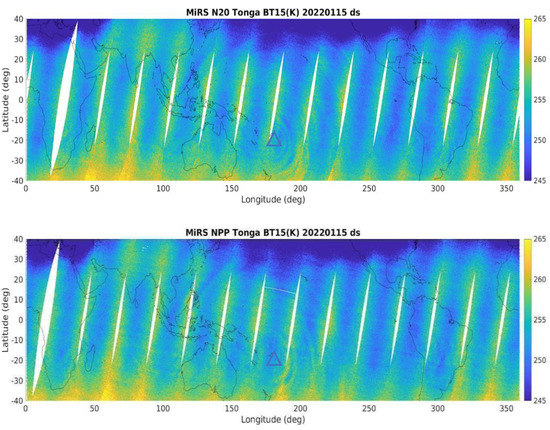
Figure 2.
ATMS Channel 15 (57.3 GHz) measured brightness temperatures NOAA−20 (upper panel) and S-NPP (lower panel) at descending (ds) node on 15 January 2022. In the figure, triangles indicated the approximate location of the volcano.
In addition to the brightness temperature from the ATMS SDR data, the retrieved temperature at the upper level of approximately 1 hPa from the ATMS SDR data also exhibits a similar feature. The Microwave Integrated Retrieval System (MIRS) processing system is a ‘microwave-only’ retrieval system based on a 1D variational and physical retrieval algorithm using the Community Radiative Transfer Model (CRTM) as the forward and adjoint operators [37,38]. The MiRS retrieval algorithm is designed as an enterprise processing system and is applied operationally on several microwave sensors from many satellite platforms, including the ATMS aboard the S-NPP/NOAA-20 satellites. The MiRS product suite includes a wide variety of surface and atmosphere products, such as temperature, water vapor, clouds, rain rate, and cryosphere products. In particular, the MiRS-retrieved temperature at 1 hPa from NOAA-20 and S-NPP is shown in Figure 3. Similarly, the observation times near Tonga are approximately 8 and 9 after the primary eruption. NOAA-20 is one-half orbit (~50 min) ahead of S-NPP. Coherent waves show eastward propagation between NOAA-20 and S-NPP observation times, with a clearer pattern than the ATMS brightness temperature distribution in Figure 1.
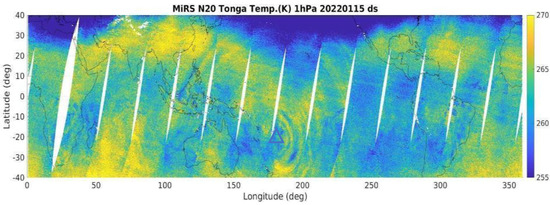
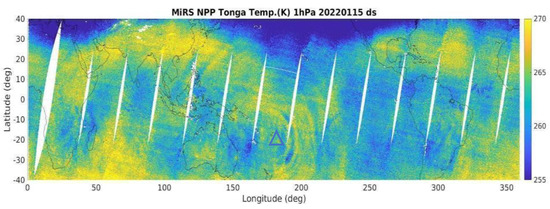
Figure 3.
MiRS Retrieved Temperature from NOAA−20 (upper panel) and S−NPP (lower panel) at 1 hPa on 15 January 2022 at descending (ds) node.
Furthermore, the 2022 Hunga Tonga volcanic eruption’s effects in the atmosphere were also captured clearly in ATMS observation minus the radiative transfer model simulation (O-B) bias global map, particularly at middle to upper-level channels. To generate the model simulated radiance, the European Centre for Medium-Range Weather Forecasts (ECMWF) global forecast field data [39], including temperature profiles, water vapor profiles, ozone mixing ratio, surface wind at U/V directions, skin temperature, and surface types, as well as unique parameters associated with different surface types, at 03, 09, 15, and 21 UTC, are interpolated into every individual ATMS field-of-view (FOV), both temporarily and spatially. The so-called first guest background data are inputted to the Community Radiative Transfer Model (CRTM) [40,41] release 2.1.3 to produce the simulated radiance at each FOV for all 22 channels. The global O-B maps are generated by subtracting the simulated radiance from the observations. Because the interpolated first guess data do not contain information about such atmospheric perturbation caused by the volcanic eruption, the biases between the real observations and simulations can distinctly show the propagation of the gravity wave centered at the volcanic eruption position in both S-NPP and NOAA-20 ATMS O-B maps on 15 January 2022, particularly from channel 9 with a peak weighting function near 200 hPa, to channel 14 with a peak weighting function higher than 10 hPa.
Illustrated in Figure 4 is the NOAA-20 ATMS channel 13 O-B global map at the descending node on 15 January 2022. The circular positive and negative bias alternative ring shape pattern indicates that there is a planetary gravity wave propagated far away from the volcano near the polar regions. The discontinuity of those rings is due to the observation delay between orbits. In addition, the O-B results reveal a more explicit ring shape pattern than those in either ATMS brightness temperature in Figure 1 or retrieved temperature products in Figure 2 above. This is primarily because the O-B contains rich information on atmospheric perturbation that is not included in the model simulation.

Figure 4.
NOAA-20 ATMS TDR Channel 13 O−B global bias map at descending node on 15 January 2022.
3.2. Hunga Tonga Volcanic Eruption Revealed by CrIS Science Data Products
The CrIS instrument aboard the S-NPP/NOAA-20 is a Fourier Transform Spectrometer (FTS) instrument with channels in three bands covering longwave (LWIR, 655–1095 cm−1), mid-wave (MWIR, 1210–1750 cm−1), and shortwave (SWIR 2155–2550 cm−1) bands [42]. The CrIS instantaneously observes nine fields of view (FOVs), with each FOV at a spatial resolution of 14 km at nadir, and the level 2 products are provided in a 3 × 3 array known as a field of regard (FOR). The instrument provides 30 FORs for each scan line of observation. Four scan lines constitute a granule, and a full day of data contains approximately 2700 granules of CrIS observations. The instrument is similar to other hyperspectral IR-sounding instruments such as the Infrared Atmospheric Sounding Interferometer (IASI) and the AIRS. Details of these instruments and their channel characteristics are described in publications [43,44].
Similar to the ATMS data, CrIS brightness temperatures showed a circular ring pattern of the gravity waves caused by the eruption, centered at the volcano (the red dot), compared to the nominal simulations within a few hours after the eruption. Additionally, a more obvious ring pattern is observed in the CrIS Long Wave Infrared (LWIR) band channel O-B bias global maps. The calculation of CrIS LWIR band simulated radiance adopts the same method as ATMS simulation. Presented in Figure 5 is the NOAA-20 CrIS O-B descending node global map at 14.93 µm. Compared to the ATMS O-B map shown in Figure 4, the CrIS O-B bias demonstrates much more detailed information about the propagation wave due to the higher resolution at each CrIS FOV, and an area of high biases located at the volcano due to its spectrum feature of this CO2 channel.
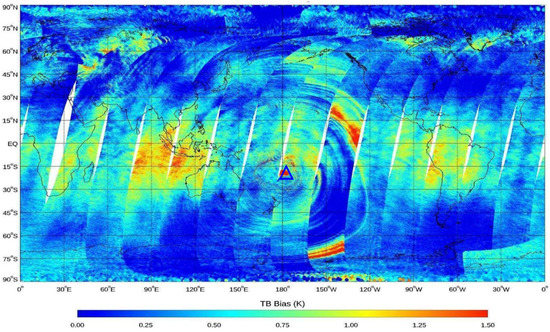
Figure 5.
NOAA-20 descending node CrIS FSR O-B global bias map at 14.93 μm on 15 January 2022.
Moreover, the NOAA/UW-CIMSS VOLcanic Cloud Analysis Toolkit (VOLCAT) consists of a series of products and services derived from multiple satellites and other data sources using artificial intelligence and other techniques. A probabilistic retrieval algorithm of volcanic SO2 layer height and partial column density using CrIS has been developed as part of the VOLCAT [45]. The SO2 cloud, as derived from CrIS/VIIRS using the VOLCAT algorithm, can track the evolution of the SO2 cloud from the eruption. An example of this VOLCAT product is shown in Figure 6.
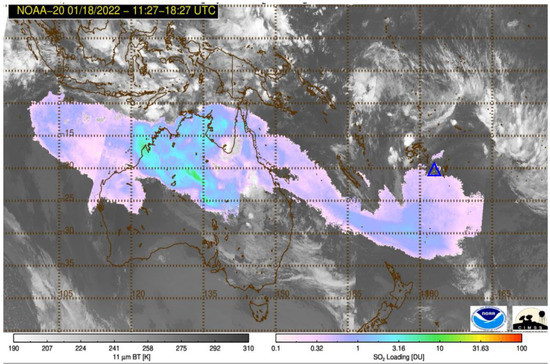
Figure 6.
SO2 Cloud as derived from CrIS and VIIRS using the VOLCAT algorithm, 18 January 2022.
3.3. Hunga Tonga Volcanic Eruption Revealed by VIIRS Science Data Products
The VIIRS instrument onboard the S-NPP/NOAA-20 satellites has transitioned much of the capability of the experimental MODerate Resolution Imaging Spectroradiometer (MODIS) instrument into the operational domain with an even more advanced instrument design and higher resolution. The instrument offers a total of 21 (plus one Day Night Band, DNB) bands with similar central wavelengths to MODIS and similar radiometric accuracy [46]. The VIIRS instrument also provides better spatial resolution (375 m for the Imaging-resolution or I-band and 750 m for Moderate-resolution or M-bands at nadir) and much-reduced variation over the 3000 km wide swath. Furthermore, the availability of the Day Night Band offers a wide variety of applications [47] and makes the JPSS operational VIIRS products vital for long-term continuity with significant operational utility. A compendium of scientific papers published by the Remote Sensing journal [48] provides complete details of the VIIRS science data products and Calibration/Validation assessments. For the Hunga Tonga volcanic eruption, the information provided by VIIRS comes primarily focused on the troposphere. The only exception is the Day Night Band, which can see emitted and reflected light from a variety of light sources [49], including faint light sources such as the mesosphere [50,51,52,53] and faint bioluminescent signals [54].
Observing gravity waves at all levels is critical to understanding the transport of energy within the atmosphere, which is only estimated in weather prediction models. This means that the capability of monitoring the troposphere all the way to the ionosphere through measurements and observations is critical to the improvement of these parameterizations in the models. One such study, which used VIIRS, has shown various tropical cyclones [55] as well as a previous explosive eruption from La Soufriere [56]. It is important to note that the waves in the mesosphere are always present. However, they are extremely faint, meaning that one cannot observe them during the day when the sun is shining and at night when the moon has relatively high illumination. In this particular case for the Hunga Tonga eruption that occurred on 15 January 2022, the moon was at the waxing gibbous phase with an illumination of 88%. This means that the reflected moonlight washes out the signal from the mesosphere, and thus the imagery from the 11µm (Figure 7) and the Day Night Band (Figure 8) can show the tropospheric gravity waves that can still be seen hours after the initial eruption. It is also worthwhile to note that the DNB shows much darker clouds from the ash, while the 11 µm channel shows how high the ash cloud reached in the atmosphere.
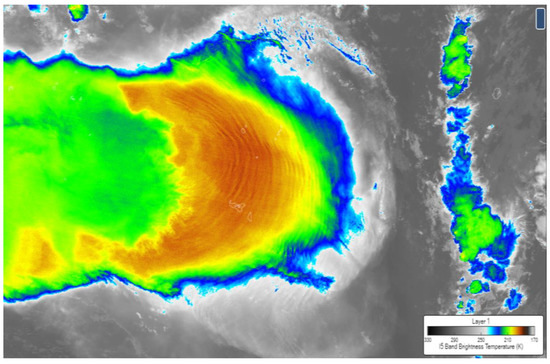
Figure 7.
Native resolution image of the S-NPP VIIRS I-5 band nighttime observations after the Tonga Volcanic eruption, showing the clear tropospheric gravity wave features at the fine resolution of 375 m.
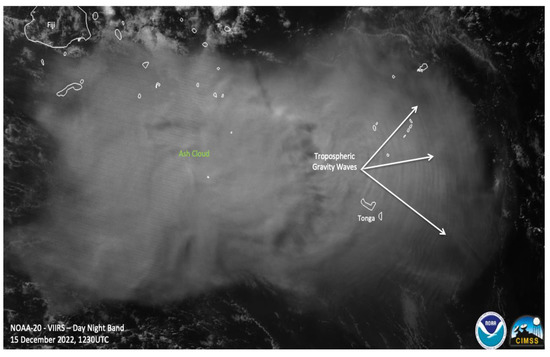
Figure 8.
The ash clouds and the tropospheric gravity waves from the Tonga Volcano as observed by the VIIRS DNB.
S-NPP and NOAA-20 VIIRS aerosol optical depth (AOD) captured the westward movement of the ash and volcanic sulfate aerosol plume from the Tonga Volcanic eruption, starting over the Pacific Ocean near Tonga and progressing across Australia to the Indian Ocean during 16–20 January. The VIIRS AOD product is a quantitative measure of the extinction (scattering and absorption) of light by aerosols in a vertical column of the atmosphere. It is a pixel-level product with high resolution (750 m at nadir) generated using the NOAA enterprise processing system (EPS) aerosol algorithm. The EPS VIIRS AOD algorithm requires observed spectral reflectances from a set of VIS/NIR bands and ancillary data sets. Unlike traditional AOD retrieval algorithms, the EPS AOD algorithm compares the VIIRS observed spectral reflectances for selected VIS and NIR bands with the reflectances calculated for a set of AOD and aerosol models. The algorithm then selects the AOD and the aerosol model for which the calculated reflectances best match the observed ones over dark and bright surfaces [57,58,59].
The upper panel of Figure 9 shows VIIRS AOD composite imagery from the S-NPP and NOAA-20 satellites on 19 January 2022, as an example of how VIIRS captured the westward movement of the aerosol plume from the volcanic eruption. By 19 January, the volcanic aerosol plume had reached northwestern Australia and the northern Indian Ocean. The gaps in the AOD images are due to clouds. The corresponding S5P TROPOMI aerosol layer height (ALH) product, also shown in the middle panel of Figure 9, supports the identification of the volcanic aerosol plume by VIIRS AOD. The area of high AODs (i.e., AOD ≥ 0.5) in Figure 9 coincides with a region of relatively high ALH (≥6 km), suggesting that the aerosol plume was elevated, as expected for the Tonga plume. TROPOMI ALH is less accurate over bright land surfaces [60], so it is not shown along the northwestern coast of Australia. The TROPOMI SO2 product in the lower panel of Figure 9 also showed excellent consistency with the VIIRS AOD. Compared with the OMPS SO2 in Figure 10 (see Section 3.4 below), the TROPOMI SO2 (5.5 km × 3.5 km resolution at the nadir) captured the SO2 plume from the volcanic eruption better due to its higher spatial resolution. Adding an enhanced/sophisticated TROPOMI-like instrument in the afternoon orbit under the JPSS Low Earth Orbit (LEO) portfolio in the future will help with the monitoring of important environmental applications like this and greatly support NOAA’s missions and priorities.
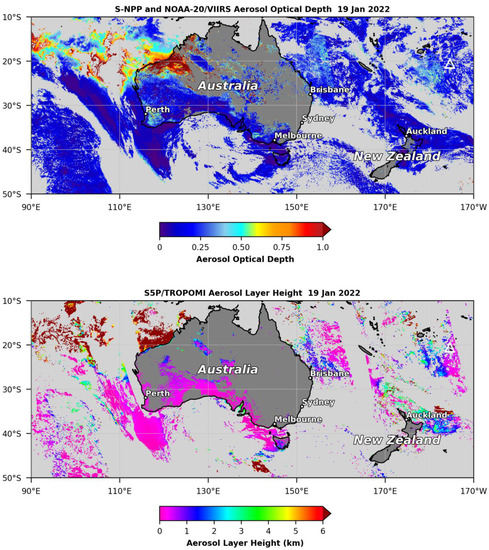
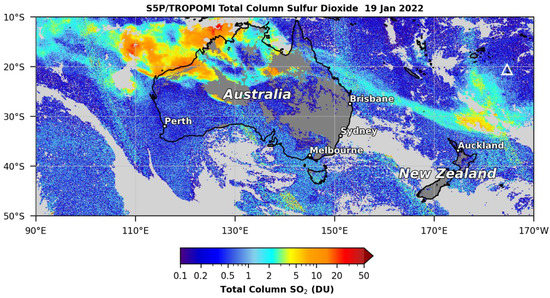
Figure 9.
Composite VIIRS aerosol optical depth (AOD) from the S-NPP and NOAA-20 satellites (upper), Sentinel-5 Precursor TROPOMI aerosol layer height (ALH) (middle), and TROPOMI SO2 (lower), showing an example of the westward progression of volcanic aerosols (AOD ≥ 0.5, ALH ≥ 6 km) reaching northwestern Australia and the northern Indian Ocean on 19 January 2022. The small triangle represents the approximate location of the Hunga-Tonga volcano.
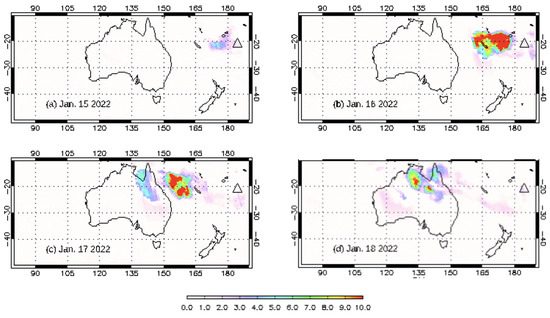
Figure 10.
S-NPP OMPS SO2 STL (Lower Stratospheric) total column products (in Dobson Units), from 15 to 18 January 2022 corresponding to (a–d) respectively. The small triangle represents the approximate location of the Hunga-Tonga volcano.
3.4. Hunga Tonga Volcanic Eruption Revealed by OMPS Science Data Products
The SO2 emitted from Volcanic eruptions into the atmosphere possesses strong absorption in 305–330 nm ultraviolet spectral region. Since 1978, the atmospheric SO2 has been estimated using backscatter ultraviolet measurements such as the Total Ozone Mapping Spectrometers (TOMS), the Global Ozone Monitoring Experiment (GOME), and the Ozone Monitoring Instrument (OMI), etc. [57]. The S-NPP OMPS has three instruments, the Nadir Mapper (OMPS-NM), Nadir Profiler (OMPS-NP), and Limb Profiler (OMPS-LP) that measures scattered solar UV and visible radiance to derive three-dimensional distributions of ozone and other atmospheric constituents for daily monitoring. The OMPS Version 8 algorithms for Total Ozone (V8TOz from OMPS-NM) and Ozone Profile (V8Pro from OMPS-NP) have the heritage of the Solar Backscatter Ultraviolet (SBUV) algorithms [61]. The OMPS-LP ozone product algorithm is based on a scattering retrieval technique used for the Shuttle Ozone Limb Sounding experiment. The NM instrument provides total column ozone (TC), UV absorbing aerosol index (UVAI), and total column SO2 at 50 km × 50 km horizontal resolution at nadir from S-NPP with 2% accuracy. For NOAA-20, these products are produced operationally at 50 km × 17 km resolution at nadir. Starting with JPSS-2 (NOAA-21), the resolution will be improved to 12 km × 10 km at nadir. The NP instrument produces middle and upper stratosphere ozone profiles in the orbital track at 250 km × 250 km (250 km × 50 km from NOAA-20) resolution with 5% accuracy and 5 to 10 km vertical resolution in the middle and upper stratosphere. The Limb Profiler (LP) currently on S-NPP (and in the future on JPSS-2) provides a high vertical resolution stratospheric ozone product at 5% accuracy and 3 km vertical resolution in the stratosphere. The OMPS-NM total column ozone products have been compared with similar products from ground-based and satellite-based instruments and validated the performance meeting the requirements.
The OMPS Near-real-time Linear Fit SO2 (LFSO2) algorithm has been running in operation at NOAA since 2018. It provides estimations of atmospheric SO2 total amount from S-NPP, NOAA-20, and future NOAA-21 observations. With this feature, the LFSO2 technique provides a nearly real-time global volcanic monitoring capability. The LFSO2 algorithms have been validated through three months of monitoring the 2018 Hawaii Kilauea volcanic activity [62]. Figure 10 shows volcanic cloud plumes observed over the Hunga Tonga region from S-NPP OMPS SO2 STL (Lower Stratospheric) total column products on four days from 15 January to 18 January 2022. The plots showed the westward transport of the SO2 clouds in the lower stratospheric layer.
4. Summary and Conclusions
This study presents observations about atmospheric features of the gravity waves due to the Tonga Volcanic eruption from the essential SDRs, O—B, and corresponding derived aerosol and SO2 products for all four advanced sensors onboard the S-NPP and NOAA-20 satellites. The SDR data can detect certain outstanding atmospheric features of the gravity wave that were induced by the volcanic eruption. This includes ATMS and CrIS brightness temperatures at upper sounding channels above 10 hPa. Additionally, with high spatial resolution, the VIIRS imagery and aerosol products also observed the clear features of the ash clouds and tropospheric gravity waves induced by the volcanic eruption. Moreover, better features are discovered from the O-B and retrieved EDR products. The O-B calculations derived from the ATMS and CrIS not only showed the horizontal structure of the gravity waves from the volcanic eruption, but also provided the vertical distribution information and revealed that the height of the temperature and moisture waves reached all the way to the stratosphere level, at least 30 km high. The MIRS temperature products derived from ATMS also depicted the gravity waves at 1 hPa level. The OMPS and CrIS SO2 products also showed the westward transport of the volcanic SO2 clouds from the eruption. Therefore, these discoveries demonstrate the scientific potential of the JPSS SDR and EDR products in visually monitoring and tracking the eruption and impact of volcanoes. More importantly, this observation capability will be continued by the upcoming JPSS-2 and future JPSS-3 and JPSS-4 satellites that carry the same instruments, and further enhanced with the next generation LEO constellation of satellites, thus enabling direct observations of future volcanoes and other extreme weather events.
Observing gravity waves at all levels is critical to understanding the transport of energy within the atmosphere, which is only estimated in weather prediction models. While this study is a good showcase of JPSS sensors for environmental monitoring, more studies need to be done to fully capture the structure of this powerful eruption and to understand any potential impacts on the stratosphere and atmosphere composition distribution and variations. Additionally, it is our plan to compare this with data available in the cited literatures for the same eruption in the future. Another interesting topic of our future plan is to explore the potential of the JPSS scientific products in capturing similar atmospheric features for different and highly explosive eruptions. Therefore, with great potential, the JPSS sensors and the derived high-quality data products from the sensors shall make more contributions in assessing environmental impacts should any extreme weather events occur.
Author Contributions
Writing—original draft, L.Z.; Writing—review & editing, B.Y., N.S., J.H., Q.L., C.G., Y.-K.L., W.S.III, J.N., A.H., S.K. and M.G. All authors have read and agreed to the published version of the manuscript.
Funding
This research work was funded by the NOAA JPSS program.
Data Availability Statement
The operational S-NPP and NOAA-20 SDR and EDR data sets are available in the NOAA Comprehensive Large Array-data Stewardship System (CLASS).
Acknowledgments
This paper describes the collective work of government industry and academic teams over the course of many years. The authors would like to acknowledge the hard work and dedication of all contributing individual companies and organizations. The manuscript contents are solely the opinions of the authors and do not constitute a statement of policy, decision, or position on behalf of NOAA or the U.S. government. The authors would like to specifically thank Drs. Shobha Kondragunta, Lawrence Flynn, Mike Pavolonis, Bill Sjoberg, Steve Miller, Bill line, Changyong Cao, and Alisa Young for their contributions to the enterprise algorithms and calibration/validation that support the results referenced in this paper.
Conflicts of Interest
The authors declare no conflict of interest.
References
- Goldberg, M.; Cikanek, H.A.; Zhou, L.; Price, J. The Joint Polar Satellite System in Comprehensive Remote Sensing: Missions and Sensors; Liang, S., Ed.; Elsevier: Lanham, MD, USA, 2018; Volume 1. [Google Scholar]
- Zhou, L.; Divakarla, M.; Liu, X.; Layns, A.; Goldberg, M. An Overview of the Science Performances and Calibration/Validation of Joint Polar Satellite System Operational Products. Remote Sens. 2019, 11, 698. [Google Scholar] [CrossRef]
- Zhou, L.; Divakarla, M.; Liu, X. An overview of the joint polar satellite system (JPSS) science data product calibration and validation. Remote Sens. 2016, 8, 139. [Google Scholar] [CrossRef]
- Joint Polar Satellite System (JPSS) Advanced Technology Microwave Sounder (ATMS) SDR Radiometric Calibration Algorithm Theoretical Basic Document (ATBD). 2011. Available online: https://www.star.nesdis.noaa.gov/jpss/documents/ATBD/D0001-M01-S01-001_JPSS_ATBD_ATMS-SDR_B.pdf (accessed on 23 January 2023).
- Joint Polar Satellite System (JPSS) Cross Track Infrared Sounder (CrIS) Sensor Data Records (SDR) Algorithm Theoretical Basis Document (ATBD), Rev C, Code 474, 474-00032. Available online: https://docserver.gesdisc.eosdis.nasa.gov/repository/Mission/SNPP_Sounder/3.3_ScienceDataProductDocumentation/3.3.4_ProductGenerationAlgorithms/D0001-M01-S01-002_JPSS_ATBD_CrIS-SDR_C.pdf (accessed on 23 January 2023).
- Joint Polar Satellite System (JPSS) OMPS Nadir Profile Ozone Algorithm Theoretical Basis Document (ATBD), JPSS Ground Project Code 474-00026; Goddard Space Flight Center: Greenbelt, MD, USA, 2014.
- Joint Polar Satellite System (JPSS) OMPS Nadir Total Column Ozone Algorithm Theoretical Basis Document (ATBD), JPSS Ground Project Code 474-00029; Goddard Space Flight Center: Greenbelt, MD, USA, 2014.
- Yan, B.; Liang, D.; Porter, W.; Huang, J.; Sun, N.; Zhou, L.; Zhu, T.; Goldberg, M.; Zhang, D.L.; Liu, Q. Gap filling of advanced technology microwave sounder data as applied to hurricane warm core animations. Earth Space Sci. 2020, 7, e2019EA000961. [Google Scholar] [CrossRef]
- Carr, J.L.; Horváth, Á.; Wu, D.L.; Friberg, M.D. Stereo plume height and motion retrievals for the record-setting Hunga Tonga-Hunga Ha’apai eruption of 15 January 2022. Geophys. Res. Lett. 2022, 49, e2022GL098131. [Google Scholar] [CrossRef]
- Harrison, G. Pressure anomalies from the January 2022 Hunga Tonga-Hunga Ha’apai eruption. Weather 2022, 77, 87–90. [Google Scholar] [CrossRef]
- Millán, L.; Santee, M.L.; Lambert, A.; Livesey, N.J.; Werner, F.; Schwartz, M.J.; Pumphrey, H.C.; Manney, G.L.; Wang, Y.; Su, H.; et al. The Hunga Tonga-Hunga Ha’apai Hydration of the Stratosphere. Geophys. Res. Lett. 2022, 49, e2022GL099381. [Google Scholar] [CrossRef]
- Yuen, D.A.; Scruggs, M.A.; Spera, F.J.; Zheng, Y.; Hu, H.; McNutt, S.R.; Thompson, G.; Mandli, K.; Keller, B.R.; Wei, S.S.; et al. Under the surface: Pressure-induced planetary-scale waves, volcanic lightning, and gaseous clouds caused by the submarine eruption of Hunga Tonga-Hunga Ha’apai volcano. Earthq. Res. Adv. 2022, 2, 100134, ISSN 2772-46700. [Google Scholar] [CrossRef]
- Poli, P.; Shapiro, N.M. Rapid characterization of large volcanic eruptions: Measuring the impulse of the Hunga Tonga explosion from teleseismic waves. Geophys. Res. Lett. 2022, 49, e2022GL098123. [Google Scholar] [CrossRef]
- Witze, A. Why the Tongan eruption will go down in the history of volcanology. Nature 2022, 602, 376–378. [Google Scholar] [CrossRef]
- Legras, B.; Duchamp, C.; Sellitto, P.; Podglajen, A.; Carboni, E.; Siddans, R.; Grooß, J.U.; Khaykin, S.; Ploeger, F. The evolution and dynamics of the Hunga Tonga plume in the stratosphere. EGUsphere, 2022; preprint. [Google Scholar] [CrossRef]
- Wright, C.J.; Hindley, N.P.; Alexander, M.J.; Barlow, M.; Hoffmann, L.; Mitchell, C.N.; Prata, F.; Bouillon, M.; Carstens, J.; Clerbaux, C.; et al. Surface-to-space atmospheric waves from Hunga Tonga–Hunga Ha’apai eruption. Nature 2022, 609, 741–746. [Google Scholar] [CrossRef]
- Proud, S.R.; Prata, A.; Schmauss, S. The January 2022 eruption of Hunga Tonga-Hunga Ha’apai volcano reached the mesosphere. Geophysics 2022, 378, 554–557. [Google Scholar] [CrossRef]
- Han, Y.; Scott, D.; Revercomb, H.; Strow, L.; Mooney, D.; Gu, D.; Cromp, M.; Johnson, D.; Ibrahim, W.; Root, C. Suomi NPP CrIS SDR Task Overview, NOAA JPSS Science Review, 18 December 2013. Available online: https://www.star.nesdis.noaa.gov/jpss/documents/AMM/NPP/CrIS_SDR_Val.pdf (accessed on 23 January 2023).
- Sanchez, F.; Tobin, D.; Strow, L.; Scott, D.; Mooney, D.; Johnson, D.; Suwinski, L.; Predina, J.; Bolen, D.; Guenther, B.; et al. NOAA-20 CrIS SDR Report for Validated Maturity Review, NOAA JPSS Science Review. 2 October 2018. Available online: https://www.star.nesdis.noaa.gov/jpss/documents/AMM/N20/CrIS_SDR_Validated.pdf (accessed on 23 January 2023).
- Wu, X.; Jaross, G.; Sen, B.; Capon, M.; Cumpto, D. Validated Maturity Review for SNPP OMPS SDR Earth View Products, NOAA JPSS Science Review. 17 August 2015. Available online: https://www.star.nesdis.noaa.gov/jpss/documents/AMM/NPP/OMPS_SDR_Val.pdf (accessed on 23 January 2023).
- Yan, B.; Pan, C.; Beck, T.; Xiong, X.; Devalie, E.-M. NOAA-20 OMPS NM SDR Report for validated Maturity Review, NOAA JPSS Science Review. November 2019. Available online: https://www.star.nesdis.noaa.gov/jpss/documents/AMM/N20/OMPS_TC_SDR_Validated.pdf (accessed on 23 January 2023).
- Yan, B.; Pan, C.; Beck, T.; NASA OMPS Instrument Group; NOAA STAR ICVS Team; OMPS EDR Team; JSTAR Team. NOAA-20 OMPS NP SDR Report for Validated Maturity Review, NOAA JPSS Science Review. April 2020. Available online: https://www.star.nesdis.noaa.gov/jpss/documents/AMM/N20/OMPS_NP_SDR_Validated.pdf (accessed on 23 January 2023).
- Cao, C.; Blonski, S.; Uprety, S.; Sun, J.; The VIIRS SDR Team. Suomi NPP VIIRS SDR Calibrated/Validated Maturity Overview, NOAA JPSS Science Review. December 2013. Available online: https://www.star.nesdis.noaa.gov/jpss/documents/AMM/NPP/VIIRS_SDR_Val.pdf (accessed on 23 January 2023).
- Cao, C.; Blonski, S.; Wang, I. Guch, Algorithm Cal/Val Team. VALIDATED MATURITY SCIENCE REVIEW FOR NOAA-20 VIIRS SDR, NOAA JPSS Science Review. 15 June 2018. Available online: https://www.star.nesdis.noaa.gov/jpss/documents/AMM/N20/VIIRS_SDR_Validated.pdf (accessed on 23 January 2023).
- McHardy, T.M.; Zhang, J.; Reid, J.S.; Miller, S.D.; Hyer, E.J.; Kuehn, R.E. An Improved Method for Retrieving Nighttime Aerosol Optical Thickness from the Viirs Day/Night Band. Atmos. Meas. Tech. 2015, 8, 4773–4783. [Google Scholar] [CrossRef]
- Csiszar, I.; Schroeder, W.; Giglio, L.; Ellicott, E.; Vadrevu, K.P.; Justice, C.O.; Wind, B. Active Fires from the Suomi Npp Visible Infrared Imaging Radiometer Suite: Product Status and First Evaluation Results. J. Geophys. Res. Atmos. 2014, 119, 803–816. [Google Scholar] [CrossRef]
- Vargas, M.; Miura, T.; Shabanov, N.; Kato, A. An Initial Assessment of Suomi Npp Viirs Vegetation Index Edr. J. Geophys. Res. Atmos. 2013, 118, 12301–12316. [Google Scholar] [CrossRef]
- Petrenko, B.; Ignatov, A.; Kihai, Y.; Stroup, J.; Dash, P. Evaluation and Selection of Sst Regression Algorithms for Jpss Viirs. J. Geophys. Res. Atmos. 2014, 119, 4580–4599. [Google Scholar] [CrossRef]
- Wang, M.; Liu, X.; Jiang, L.; Son, S.; Sun, J.; Shi, W.; Tan, L.; Naik, P.; Mikelsons, K.; Wang, X.; et al. Evaluation of Viirs Ocean Color Products. SPIE Asia-Pac. Remote Sens. 2014, 9261, 69–83. [Google Scholar]
- Zhang, H.; Kondragunta, S.; Laszlo, I.; Liu, H.; Remer, L.A.; Huang, J.; Superczynski, S.; Ciren, P. An Enhanced Viirs Aerosol Optical Thickness (Aot) Retrieval Algorithm over Land Using a Global Surface Reflectance Ratio Database: Enhanced Viirs Aot Retrieval Alg. Land. J. Geophys. Res. Atmos. 2016, 121, 10–717. [Google Scholar]
- Pavolonis, M.J.; Heidinger, A.K.; Sieglaff, J. Automated Retrievals of Volcanic Ash and Dust Cloud Properties from Upwelling Infrared Measurements. J. Geophys. Res. Atmos. 2013, 118, 1436–1458. [Google Scholar] [CrossRef]
- Key, J.R.; Mahoney, R.; Liu, Y.; Romanov, P.; Tschudi, M.; Appel, I.; Maslanik, J.; Baldwin, D.; Wang, X.; Meade, P. Snow and Ice Products from Suomi Npp Viirs. J. Geophys. Res. Atmos. 2013, 118, 12816–12830. [Google Scholar] [CrossRef]
- Gambacorta, A.; Nalli, N.R.; Barnet, C.D.; other co-authors. The Noaa Unique Combined Atmospheric Processing System (Nucaps) Algorithm Theoretical Basis Document. Available online: https://www.star.nesdis.noaa.gov/jpss/documents/ATBD/ATBD_NUCAPS_v3.1.pdf (accessed on 23 January 2023).
- Nalli, N.R.; Gambacorta, A.; Liu, Q.; Barnet, C.D.; Tan, C.; Iturbide-Sanchez, F.; Reale, T.; Sun, B.; Wilson, M.; Borg, L.; et al. Validation of Atmospheric Profile Retrievals from the Snpp Noaa-Unique Combined Atmospheric Processing System. Part 1: Temperature and Moisture. IEEE Trans. Geosci. Remote Sens. 2018, 56, 180–190. [Google Scholar] [CrossRef]
- Nalli, N.R.; Gambacorta, A.; Liu, Q.; Tan, C.; Iturbide-Sanchez, F.; Barnet, C.D.; Joseph, E.; Morris, V.R.; Oyola, M.; Smith, J.W. Validation of Atmospheric Profile Retrievals from the Snpp Noaa-Unique Combined Atmospheric Processing System. Part 2: Ozone. IEEE Trans. Geosci. Remote Sens. 2018, 56, 598–607. [Google Scholar] [CrossRef]
- Meng, H.; Dong, J.; Ferraro, R.; Yan, B.; Zhao, L.; Kongoli, C.; Wang, N.Y.; Zavodsky, B. A 1dvar-Based Snowfall Rate Retrieval Algorithm for Passive Microwave Radiometers. J. Geophys. Res. Atmos. 2017, 122, 6520–6540. [Google Scholar] [CrossRef]
- Bukabara, S.A.; Garrett, K.; Chen, W.C.; Iturbide-Sanchez, F.; Grassotti, C.; Kongoli, C.; Chen, R.Y.; Liu, Q.H.; Yan, B.H.; Weng, F.Z.; et al. MiRS: An All-Weather 1DVAR Satellite Data Assimilation and Retrieval System. IEEE Trans. Geosci. Remote Sens. 2011, 49, 3249–3272. [Google Scholar] [CrossRef]
- Boukabara, S.A.; Garrett, K.; Grassotti, C.; Iturbide-Sanchez, F.; Chen, W.; Jiang, Z.; Clough, S.A.; Zhan, X.; Liang, P.; Liu, Q.; et al. A Physical Approach for a Simultaneous Retrieval of Sounding, Surface, Hydrometeor, and Cryospheric Parameters from SNPP/ATMS. J. Geophys. Res. -Atmos. 2013, 118, 12600–12619. [Google Scholar] [CrossRef]
- Owens, R.G.; Hewson, T.D. ECMWF Forecast User Guide; ECMWF: Reading, UK, 2018; Volume 10, p. m1cs7h. [Google Scholar]
- Han, Y.; van Delst, P.; Liu, Q.; Weng, F.; Yan, B.; Treadon, R.; Derber, J. JCSDA Community Radiative Transfer Model (CRTM): Version 1; NOAA Tech. Rep. NESDIS 122; NOAA: Silver Spring, MD, USA, 2006; p. 33.
- Liu, Q.; Boukabara, S. Community Radiative Transfer Model (CRTM) applications in supporting the Suomi National Polar-orbiting Partnership (SNPP) mission validation and verification. Remote Sens. Environ. 2014, 140, 744–754. [Google Scholar] [CrossRef]
- Lee, T.F.; Nelson, C.S.; Dills, P.; Riishojgaard, L.P.; Jones, A.; Li, L.; Miller, S.; Flynn, L.E.; Jedlovec, G.; McCarty, W.; et al. Npoess. Bull. Am. Meteorol. Soc. 2009, 91, 727–740. [Google Scholar] [CrossRef]
- Han, Y.; Chen, Y. Calibration Algorithm for Cross-Track Infrared Sounder Full Spectral Resolution Measurements. IEEE Trans. Geosci. Remote Sens. 2018, 56, 1008–1016. [Google Scholar] [CrossRef]
- Han, Y.; Revercomb, H.; Cromp, M.; Gu, D.; Johnson, D.; Mooney, D.; Scott, D.; Strow, L.; Bingham, G.; Borg, L.; et al. Suomi NPP CrIS measurements, sensor data record algorithm, calibration and validation activities, and record data quality. J. Geophys. Res. Atmos. 2013, 118, 12734–12748. [Google Scholar] [CrossRef]
- Hyman, D.M.; Pavolonis, M.J. Probabilistic retrieval of volcanic SO2 layer height and partial column density using the Cross-track Infrared Sounder (CrIS). Atmos. Meas. Tech. 2020, 13, 5891–5921. [Google Scholar] [CrossRef]
- Cao, C.; Bai, Y. Quantitative Analysis of VIIRS DNB Nightlight Point Source for Light Power Estimation and Stability Monitoring. Remote Sensing EJOU 2014, 6, 11915–11935. [Google Scholar] [CrossRef]
- Hillger, D.; Kopp, T.; Lee, T.; Lindsey, D.; Seaman, C.; Miller, S.; Solbrig, J.; Kidder, S.; Bachmeier, S.; Jasmin, T.; et al. First-light imagery from Suomi NPP VIIRS. Bull. Am. Meteorol. Soc. 2013, 94, 1019–1029. [Google Scholar] [CrossRef]
- Hillger, D.; Kopp, T.; Seaman, C.; Miller, S.; Lindsey, D.; Stevens, E.; Solbrig, J.; Terborg, A.; Kreller, M.; Kuciauskas, A.; et al. User validation of VIIRS satellite imagery. Remote Sens. 2016, 8, 11. [Google Scholar] [CrossRef]
- Cao, C.; Xiong, J.; Blonski, S.; Liu, Q.; Uprety, S.; Shao, X.; Bai, Y.L.; Weng, F. Suomi NPP VIIRS sensor data record verification, validation, and long-term performance monitoring. J. Geophys. Res. Atmos. 2013, 118, 11664–11678. [Google Scholar] [CrossRef]
- Miller, S.D.; Straka III, W.; Mills, S.P.; Elvidge, C.D.; Lee, T.F.; Solbrig, J.; Walther, A.; Heidinger, A.K.; Weiss, S.C. Illuminating the capabilities of the suomi national polar-orbiting partnership (NPP) visible infrared imaging radiometer suite (VIIRS) day/night band. Remote Sens. 2013, 5, 6717–6766. [Google Scholar] [CrossRef]
- Miller, S.D.; Straka III, W.C.; Yue, J.; Smith, S.M.; Alexander, M.J.; Hoffmann, L.; Setvák, M.; Partain, P.T. Upper atmospheric gravity wave details revealed in nightglow satellite imagery. Proc. Natl. Acad. Sci. USA 2015, 112, E6728–E6735. [Google Scholar] [CrossRef]
- Azeem, I.; Yue, J.; Hoffmann, L.; Miller, S.D.; Straka, W.C., III; Crowley, G. Multisensor profiling of a concentric gravity wave event propagating from the troposphere to the ionosphere. Geophys. Res. Lett. 2015, 42, 7874–7880. [Google Scholar] [CrossRef]
- Yue, J.; Miller, S.D.; Hoffmann, L.; Straka, W.C., III. Stratospheric and mesospheric concentric gravity waves over tropical cyclone Mahasen: Joint AIRS and VIIRS satellite observations. .J. Atmos. Sol. -Terr. Phys. 2014, 119, 83–90. [Google Scholar] [CrossRef]
- Miller, S.D.; Haddock, S.H.; Straka, W.C.; Seaman, C.J.; Combs, C.L.; Wang, M.; Shi, W.; Nam, S. Honing in on bioluminescent milky seas from space. Sci. Rep. 2021, 11, 1–10. [Google Scholar] [CrossRef]
- Xu, S.; Yue, J.; Xue, X.; Vadas, S.L.; Miller, S.D.; Azeem, I.; Straka III, W.; Hoffmann, L.; Zhang, S. Dynamical coupling between hurricane matthew and the middle to upper atmosphere via gravity waves. J. Geophys. Res. Space Phys. 2019, 124, 3589–3608. [Google Scholar] [CrossRef]
- Yue, J.; Miller, S.D.; Straka III, W.C.; Noh, Y.J.; Chou, M.Y.; Kahn, R.; Flower, V. La Soufriere volcanic eruptions launched gravity waves into Space. Geophys. Res. Lett. 2022, 49, e2022GL097952. [Google Scholar] [CrossRef]
- Laszlo, I.; Liu, H. EPS Aerosol Optical Depth (AOD) Algorithm Theoretical Basis Document, NOAA-NESDIS-STAR, Center for Satellite Applications and Research. 2022. Available online: https://www.star.nesdis.noaa.gov/jpss/documents/ATBD/ATBD_EPS_Aerosol_AOD_v3.4.pdf (accessed on 23 January 2023).
- Huang, J.; Kondragunta, S.; Laszlo, I.; Liu, H.; Remer, L.A.; Zhang, H.; Superczynski, S.; Ciren, P.; Holben, B.N.; Petrenko, M. Validation and Expected Error Estimation of Suomi-Npp Viirs Aerosol Optical Thickness and Ångström Exponent with Aeronet: Validation of Viirs Aerosol Products. J. Geophys. Res. Atmos. 2016, 121, 7139–7160. [Google Scholar] [CrossRef]
- Kondragunta, S.; Laszlo, I.; Ciren, P.; Zhang, H.; Liu, H.; Huang, J.; Huff, A. Exceptional Events Monitoring Using S-Npp Viirs Aerosol Products. In Proceedings of the 2017 IEEE International Geoscience and Remote Sensing Symposium (IGARSS), Fort Worth, TX, USA, 23–28 July 2017. [Google Scholar]
- De Graaf, M. S5P Mission Performance Centre Aerosol Layer Height [L2__AER_LH] Readme. 2022. Available online: https://sentinel.esa.int/documents/247904/3541451/Sentinel-5P-Aerosol-Layer-Height-Product-Readme-File.pdf (accessed on 23 January 2023).
- Flynn, L.; Long, C.; Wu, X.; Evans, R.; Beck, C.T.; Petropavlovskikh, I.; McConville, G.; Yu, W.; Zhang, Z.; Niu, J.; et al. Performance of the ozone mapping and profiler suite (OMPS) products. J. Geophys. Res. 2014, 119, 6181–6195. [Google Scholar] [CrossRef]
- Niu, J.; Flynn, L.E.; Beck, T.; Zhang, Z.; Beach, E. Evaluation and Improvement of the Near-Real-Time Linear Fit SO2 Retrievals from Suomi NPP Ozone Mapping and Profiler Suite. IEEE Trans. Geosci. Remote Sens. 2021, 59, 101–113. [Google Scholar] [CrossRef]
Disclaimer/Publisher’s Note: The statements, opinions and data contained in all publications are solely those of the individual author(s) and contributor(s) and not of MDPI and/or the editor(s). MDPI and/or the editor(s) disclaim responsibility for any injury to people or property resulting from any ideas, methods, instructions or products referred to in the content. |
© 2023 by the authors. Licensee MDPI, Basel, Switzerland. This article is an open access article distributed under the terms and conditions of the Creative Commons Attribution (CC BY) license (https://creativecommons.org/licenses/by/4.0/).